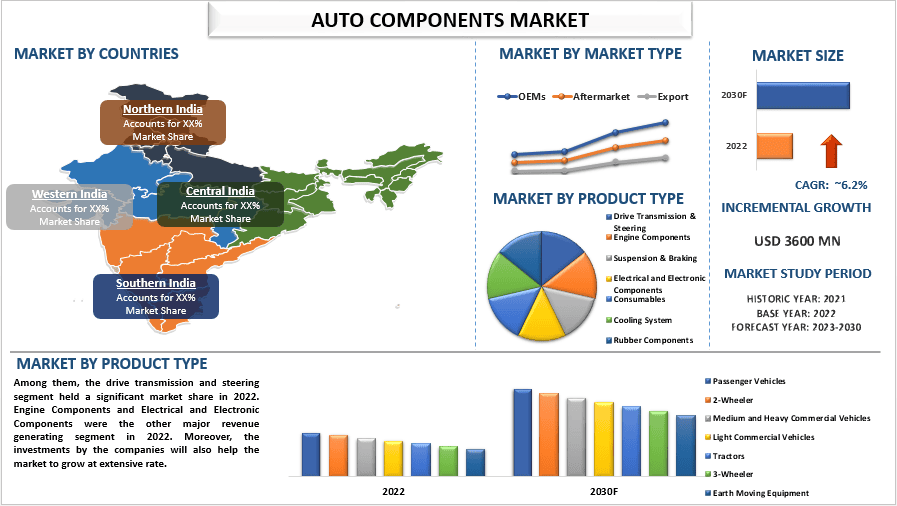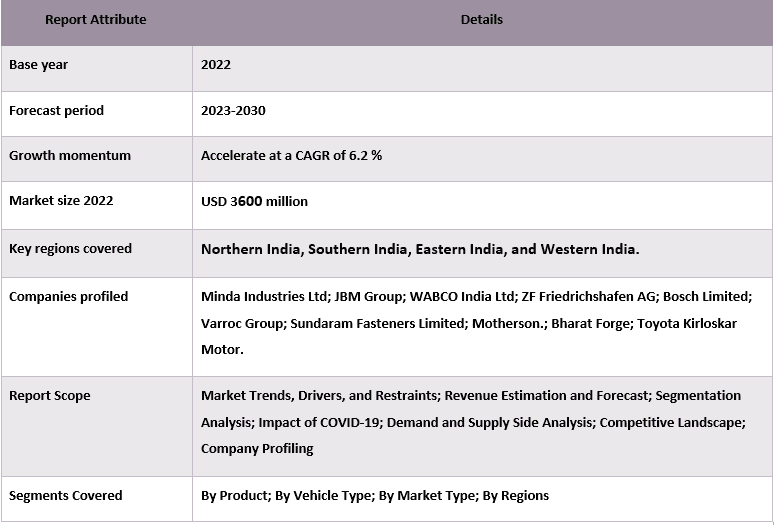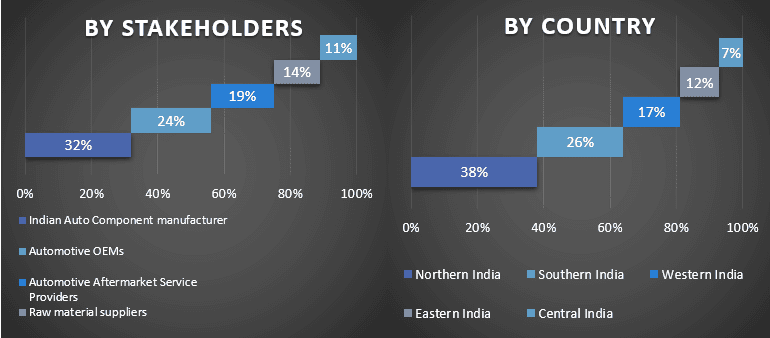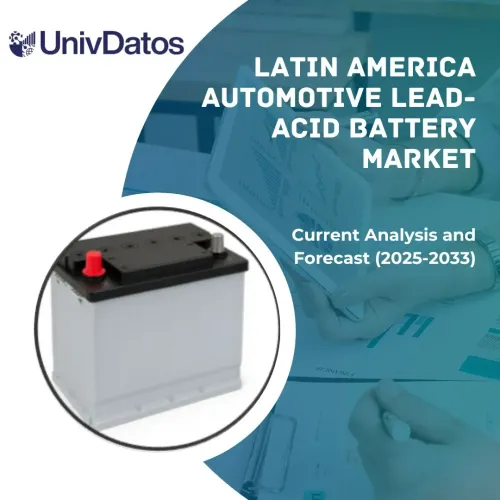- Home
- About Us
- Industry
- Services
- Reading
- Contact Us
Indian Auto Components Market: Current Analysis and Forecast (2023-2030)
Emphasis on Technology (Hydrogen Blend, Hydrogen Ready, and Hydrogen Blend-Ready); and Region/Country

The India auto components market was valued at USD 3600 million in the year 2022 and is expected to grow at a strong CAGR of around 6.2% during the forecast period (2023-2030). India’s auto components market is growing due to a number of factors, including the steady growth of the Indian automotive industry, driven by increasing consumer demand and disposable income, has led to an increase in demand for innovative and advanced auto components. The government’s pro-domestic manufacturing policies, such as “Make in India,” have encouraged both domestic and international auto component manufacturers to set up manufacturing plants in India. The electric and hybrid vehicle segments, driven by environmental issues and regulatory frameworks, have opened up new avenues for specialized component production.
Some of the major players operating in the market include Minda Industries Ltd; JBM Group; WABCO India Ltd; ZF Friedrichshafen AG; Bosch Limited; Varroc Group; Sundaram Fasteners Limited; Motherson.; Bharat Forge; Toyota Kirloskar Motor. Several M&As along with partnerships have been undertaken by these players to facilitate customers with hi-tech and innovative products/technologies.
Insights Presented in the Report
“Based on product, the Indian Auto Component Market is segmented into Drive Transmission & Steering, Engine Components, Suspension & Braking, Electrical and Electronic Components, Consumables, Cooling System, Rubber Components. Among them, the drive transmission and steering segment is expected to hold a significant market share during forecast period.
Based on product, the Indian Auto Component Market is segmented into Drive Transmission & Steering, Engine Components, Suspension & Braking, Electrical and Electronic Components, Consumables, Cooling System, Rubber Components. Among them, the drive transmission and steering segment is expected to hold a significant market share during forecast period. Engine Components and Electrical and Electronic Components were the other major revenue generating segment in 2022. Moreover, the investments by the companies will also help the market to grow at extensive rate. For instance, Bosch announced to invest INR 20 crore (US$ 2.84 million) between FY2020-2025 in its Robert Bosch Center for Data Science and Artificial Intelligence (RBC-DSAI) at the Indian Institute of Technology-Madras (IIT-M).
“Based on vehicle type, the Indian Auto Component Market is divided into Passenger Vehicles, 2-Wheeler, Medium and Heavy Commercial Vehicles, Light Commercial Vehicles, Tractors, 3-Wheeler, Earth Moving Equipment.
Based on vehicle type, the Indian Auto Component Market is divided into Passenger Vehicles, 2-Wheeler, Medium and Heavy Commercial Vehicles, Light Commercial Vehicles, Tractors, 3-Wheeler, Earth Moving Equipment. Among these, the passenger vehicle segment is expected to hold a considerable share of the market during the forecast period. A few major factors such as growing disposable income of the populace and changing lifestyle of the consumers are driving the growth of the segment.
“Northern India is expected to hold the highest market share of market during forecast period.”
Northern India is considered as one of the largest markets for vehicles in India, providing major growth opportunity for the auto component manufacturer. Both domestic and export markets are almost similar in terms of potential share by different product types. Engine and Exhaust components along with Body & Structural parts are expected to make up nearly 50% of the potential domestic sales as well as export in 2021. In March 2021, the government announced to offer fresh incentives to companies making electric vehicles (EVs) as part of a broad auto sector scheme. The scheme is expected to attract US$ 14 billion in investment in the next five years. Further, to increase adoption of electric vehicles, the Indian government is expected to roll out new low-cost AC charging points, which will result in reducing the initial set-up cost. The price set for the low-cost EV charging point is Rs. 3,500 (US$ 47.79).
India Auto Components Market Report Coverage

Reasons to buy this report:
- The study includes market sizing and forecasting analysis validated by authenticated key industry experts.
- The report presents a quick review of overall industry performance at one glance.
- The report covers an in-depth analysis of prominent industry peers with a primary focus on key business financials, product portfolios, expansion strategies, and recent developments.
- Detailed examination of drivers, restraints, key trends, and opportunities prevailing in the industry.
- The study comprehensively covers the market across different segments.
- Deep dive regional level analysis of the industry.
Customization Options:
The India auto components Market can further be customized as per the requirement or any other market segment. Besides this, UMI understands that you may have your own business needs, hence feel free to contact us to get a report that completely suits your requirements.
Table of Content
Research Methodology for the India Auto Components Market Analysis (2023-2030)
Analyzing the historical market, estimating the current market, and forecasting the future market of the India auto components Market were the three major steps undertaken to create and analyze the adoption of valves in major regions globally. Exhaustive secondary research was conducted to collect the historical market numbers and estimate the current market size. Secondly, to validate these insights, numerous findings and assumptions were taken into consideration. Moreover, exhaustive primary interviews were also conducted, with industry experts across the value chain of the India auto components Market. Post assumption and validation of market numbers through primary interviews, we employed a top-down/bottom-up approach to forecasting the complete market size. Thereafter, market breakdown and data triangulation methods were adopted to estimate and analyze the market size of segments and sub-segments of the industry pertains to. Detailed methodology is explained below:
Analysis of Historical Market Size
Step 1: In-Depth Study of Secondary Sources:
Detail secondary study was conducted to obtain the historical market size of the India auto components Market through company internal sources such as annual reports & financial statements, performance presentations, press releases, etc., and external sources including journals, news & articles, government publications, competitor publications, sector reports, third-party database, and other credible publications.
Step 2: Market Segmentation:
After obtaining the historical market size of the India auto components market, we conducted a detailed secondary analysis to gather historical market insights and share for different segments & sub-segments for major regions. Major segments are included in the report as product, vehicle type, and market type. Further country-level analyses were conducted to evaluate the overall adoption of testing models in that region.
Step 3: Factor Analysis:
After acquiring the historical market size of different segments and sub-segments, we conducted a detailed factor analysis to estimate the current market size of the India auto components Market. Further, we conducted factor analysis using dependent and independent variables such as product, vehicle type, and market type of the India auto components Market. A thorough analysis was conducted for demand and supply-side scenarios considering top partnerships, mergers and acquisitions, business expansion, and product launches in the India auto components Market sector across the globe.
Current Market Size Estimate & Forecast
Current Market Sizing: Based on actionable insights from the above 3 steps, we arrived at the current market size, key players in the India auto components market, and market shares of the segments. All the required percentage shares split, and market breakdowns were determined using the above-mentioned secondary approach and were verified through primary interviews.
Estimation & Forecasting: For market estimation and forecast, weights were assigned to different factors including drivers & trends, restraints, and opportunities available for the stakeholders. After analyzing these factors, relevant forecasting techniques i.e., the top-down/bottom-up approach were applied to arrive at the market forecast for 2030 for different segments and sub-segments across the major markets globally. The research methodology adopted to estimate the market size encompasses:
- The industry’s market size, in terms of revenue (USD) and the adoption rate of the India auto components Market across the major markets domestically
- All percentage shares, splits, and breakdowns of market segments and sub-segments
- Key players in the India auto components Market in terms of products offered. Also, the growth strategies adopted by these players to compete in the fast-growing market
Market Size and Share Validation
Primary Research: In-depth interviews were conducted with the Key Opinion Leaders (KOLs) including Top Level Executives (CXO/VPs, Sales Head, Marketing Head, Operational Head, Regional Head, Country Head, etc.) across major regions. Primary research findings were then summarized, and statistical analysis was performed to prove the stated hypothesis. Inputs from primary research were consolidated with secondary findings, hence turning information into actionable insights.
Split of Primary Participants in Different Countries

Market Engineering
The data triangulation technique was employed to complete the overall market estimation and to arrive at precise statistical numbers for each segment and sub-segment of the India auto components Market. data was split into several segments & sub-segments post studying various parameters and trends in the areas of the product, vehicle type, and market type in the India auto components Market.
The main objective of the Indian auto components Market Study
The current & future market trends of the India auto components Market were pinpointed in the study. Investors can gain strategic insights to base their discretion for investments on the qualitative and quantitative analysis performed in the study. Current and future market trends determined the overall attractiveness of the market at a regional level, providing a platform for the industrial participant to exploit the untapped market to benefit from a first-mover advantage. Other quantitative goals of the studies include:
- Analyze the current and forecast market size of the Indian auto components Market in terms of value (USD). Also, analyze the current and forecast market size of different segments and sub-segments.
- Segments in the study include areas of the product, vehicle type, and market type.
- Define and analysis of the regulatory framework for the manufacturing
- Analyze the value chain involved with the presence of various intermediaries, along with analyzing customer and competitor behaviors of the industry.
- Analyze the current and forecast market size of the Indian auto components Market for the major region.
- Major countries studied in the report include Northern India, Southern India, Eastern India, and Western India.
- Company profiles of the India auto components Market and the growth strategies adopted by the market players to sustain in the fast-growing market.
- Deep dive regional level analysis of the industry
Related Reports
Customers who bought this item also bought










